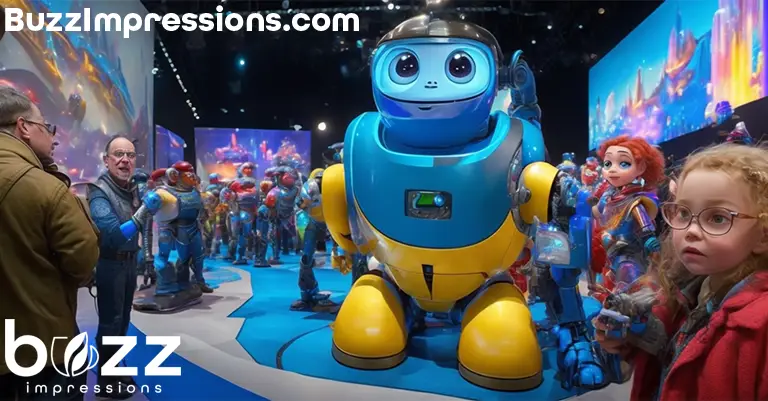Step into the future of trade shows! Are you familiar with the word ‘Artificial Intelligence’ and curious about how it can revolutionize the trade show industry? Well, you’re in the right place! In the next few minutes, you’ll uncover how to blend AI into this dynamic industry seamlessly. We’ll delve into the essence of trade show artificial intelligence, explore its practical applications, discuss potential challenges, and examine its promising future in the trade show industry. Grab a coffee and get comfortable because this will be an enlightening journey!
What is Artificial Intelligence (AI)?
AI and Machine Learning Basics
Artificial Intelligence (AI), a term you may have encountered numerous times, is no longer just a concept in sci-fi novels or Hollywood blockbusters. Rather, it has become an integral part of our daily lives. AI is a multidisciplinary field of computer science designed to create systems capable of mimicking human intelligence. These systems can learn, reason, perceive, infer, communicate, and make decisions while learning from past experiences and adjusting to new inputs.
In the AI realm, a subfield is called Machine Learning (ML). ML algorithms enable computers to learn and improve from experience. Rather than being explicitly programmed to carry out a task, these systems are trained using large amounts of data and algorithms, enabling them to learn how to perform the task independently. It’s like equipping computers with a brain that can learn, analyze, and make informed decisions.

The Potential of AI in Business Applications
The potential of AI extends far beyond our imagination. In the business world, AI transforms traditional operations, drives efficiencies, boosts productivity, and revolutionizes customer experiences. AI is a game-changer across all sectors, from automating repetitive tasks to predicting future trends.
With AI, businesses can gain valuable insights from their data to drive strategic decision-making. AI-powered chatbots can engage with customers 24/7, delivering personalized interactions. Predictive analytics, another application of AI, allows businesses to anticipate customer behaviors and market trends, thereby devising more effective strategies.
Moreover, AI can enhance operations and reduce costs by automating routine tasks. From data entry to managing customer queries, AI helps free up human resources for more strategic, value-adding tasks. The possibilities with AI are immense and reshaping how we conduct business. Now, imagine the transformations it can bring to the trade show industry. Intriguing, right? Let’s dive into that next.
An Overview of the Trade Show Industry
The Purpose and Importance of Trade Shows
Trade shows serve as a dynamic platform for businesses to showcase their products or services, share knowledge, network, and collaborate. They offer a unique, hands-on experience, allowing companies to engage directly with potential clients, industry partners, and influencers. In essence, trade shows allow businesses to tell their story, demonstrating what they offer and why they matter.
The value of trade shows extends beyond marketing. They provide insights into industry trends, facilitate competitive analysis, and offer networking opportunities that can lead to strategic partnerships. Trade shows can even serve as a launchpad for new products or ideas, making them an integral part of business development strategies.

The Current State of the Trade Show Industry
The trade show industry has seen numerous changes, with technology playing a crucial role in shaping its evolution. The advent of digital media and online platforms has diversified the way companies participate in trade shows, extending their reach beyond physical boundaries. Despite these changes, the importance of in-person connections made at trade shows remains undiminished.
However, the global pandemic has undeniably impacted the industry, leading to a surge in virtual trade shows. With digital platforms stepping into the spotlight, exhibitors and attendees alike have had to adapt to this new format.
Yet, as we emerge from the pandemic, there is a renewed appreciation for the value of face-to-face interactions, and the industry is witnessing a resurgence of physical trade shows. The future, it seems, is a blend of physical and virtual trade shows, providing flexibility and maximizing reach.
In this evolving landscape, the integration of AI holds enormous potential to transform the trade show experience, bridging the gap between the physical and digital and enhancing value for exhibitors and attendees. Let’s explore how.
The Need for AI in the Trade Show Industry
Enhancing Efficiency
Trade shows are complex events, laden with numerous tasks such as registration, setting up exhibits, scheduling, managing attendee queries, and more. Organizers, exhibitors, and attendees all share a common desire: increased efficiency. This is where AI comes in. With AI’s ability to automate repetitive tasks, predict trends, and analyze data, efficiency can be significantly boosted.
AI-powered tools can streamline event registration, making it faster and more user-friendly. AI-driven bots can address common attendee queries, freeing the staff to handle more complex tasks. Predictive analytics can help organizers anticipate attendee preferences, optimizing the event layout and schedule accordingly.
Simply put, AI has the potential to minimize the mundane and maximize meaningful trade show experiences, leading to increased satisfaction for all involved parties.

Personalized Experiences
Personalization is the new mantra in the business world. Consumers crave experiences tailored to their specific interests and needs. Trade shows are no different. Attendees want to feel that the event is catered to their interests, helping them meet the right people, attend the right sessions, and find the right products or services.
This is another area where AI shines. By analyzing attendees’ behaviors and preferences, AI can offer personalized recommendations for sessions to attend, people to meet, or booths to visit. AI can even tailor marketing and communication to individuals, enhancing their engagement and satisfaction.
In essence, AI has the potential to transform trade shows from generic events into personalized experiences, making them more engaging and effective. And guess what? This is just the tip of the iceberg. AI’s applications in the trade show industry extend further, as we will explore next.
Practical Applications of AI in Trade Shows
AI for Improved Customer Service
Customer service is paramount in the trade show industry. Exhibitors and attendees expect quick and accurate responses to their inquiries. Here, AI, particularly in the form of chatbots, can be a game-changer. AI-powered chatbots can handle routine inquiries 24/7, ensuring attendees and exhibitors receive immediate assistance, even when human staff is unavailable.
AI can also enhance the quality of service. Through Natural Language Processing (NLP), a subset of AI, chatbots can understand and respond to inquiries more naturally and accurately. This provides a more satisfying and efficient customer service experience, improving relationships with attendees and exhibitors.
Predictive Analysis for Better Planning
Planning a trade show involves many decisions – from selecting the venue to scheduling sessions, predicting attendee preferences, and optimizing booth locations. Making these decisions based on intuition or experience can lead to suboptimal results.
With AI’s predictive analytics capabilities, this can change. By analyzing historical data, AI can predict trends and preferences, allowing organizers to make data-driven decisions. AI can help forecast attendee turnout, predict popular sessions, optimize booth allocation, and more. This leads to better planning, enhanced attendee satisfaction, and a successful trade show.

AI-Powered Matchmaking
One of the main draws of trade shows is networking opportunities. Attendees are eager to connect with the right exhibitors and vice versa. Traditional matchmaking methods, like printed directories or random encounters, can be hit-or-miss.
Enter AI-powered matchmaking. AI can suggest the most relevant connections to exhibitors and attendees by analyzing attendees’ profiles, interests, and behaviors. This maximizes the networking value of trade shows, ensuring attendees meet the people they’re most interested in and exhibitors connect with potential clients. Talk about a win-win situation!
These are just a few examples of how AI can transform the trade show industry. But what about the digital realm, especially considering the rise of virtual trade shows? Let’s see how AI fits into that picture next.
AI and Virtual Trade Shows
AI’s Role in Virtual Events
As the trade show industry adapts to a post-pandemic world, virtual trade shows have become a vital complement to physical events. They offer the advantage of global reach, overcoming geographical limitations, and providing flexibility to attendees.
In this new setting, AI can significantly enhance the virtual event experience. AI can aid in attendee engagement, which can be a challenge in virtual settings, by offering interactive features like live polls, quizzes, and Q&A sessions. AI-powered analytics can provide real-time insights into attendee behavior, helping organizers adapt on the fly to improve the event.
AI can also improve accessibility in virtual events. AI-powered transcription services can provide real-time captions for live sessions, making them more accessible to attendees with hearing impairments or language barriers.

Virtual Assistants and Chatbots in Trade Shows
Virtual assistants and chatbots are proving invaluable in virtual trade shows. They can handle various tasks, such as guiding attendees through the virtual platform, answering FAQs, and providing technical support.
Chatbots can also play an active role in driving engagement. They can notify attendees about upcoming sessions, remind them of their scheduled meetings, or suggest sessions and exhibitors based on their interests.
AI’s capacity to improve virtual trade shows is clear. Yet, as with any technology, AI integration in the trade show industry isn’t without challenges. Let’s examine some potential hurdles and how they can be addressed.
Potential Challenges of AI Integration
Data Privacy Concerns
With AI’s extensive use of data, privacy concerns inevitably arise. Attendees may be wary of how their data is collected, used, and stored. Exhibitors may have reservations about sharing their intellectual property. Therefore, ensuring robust data privacy measures is crucial when integrating AI into trade shows.
Transparency can play a key role in addressing privacy concerns. Clear communication about how data is collected, what it is used for, and how it is protected can build trust. Employing stringent data security measures like encryption and secure cloud storage can further alleviate concerns. Ensuring AI integration complies with all relevant data protection regulations is essential.

Technical Hurdles
Implementing AI technology requires technical expertise and resources. Not all trade show organizers may possess the necessary skills in-house. Moreover, AI applications need to be seamlessly integrated into the existing trade show management systems, which can be complex.
Outsourcing to AI specialists can be a solution. However, ensuring the service provider deeply understands the trade show industry is crucial. Training in-house staff in AI basics can also be beneficial.
In the case of virtual trade shows, ensuring a smooth user experience can be a challenge, particularly for attendees who are not tech-savvy. Clear instructions, intuitive design, and readily available technical support can help mitigate this issue.
Despite these challenges, the potential benefits of AI in the trade show industry make it an opportunity worth pursuing. With careful planning and execution, AI can significantly enhance the trade show experience for all stakeholders. As we conclude, let’s look into the future of AI in trade shows.
The Future of AI in the Trade Show Industry
Looking ahead, the role of AI in trade shows is expected to grow, driving innovation and adding value to all stakeholders. As AI technologies evolve, we can expect more sophisticated applications that deliver even more personalized and engaging experiences.
Regarding customer service, AI chatbots will likely become more advanced, capable of handling complex inquiries easily and precisely. Imagine a chatbot that not only answers your questions but also anticipates your needs, offering help even before you ask for it.
AI will also play a more significant role in data analysis. Advanced predictive models will allow for better planning and decision-making, further enhancing the efficiency and effectiveness of trade shows.
The fusion of AI and virtual reality (VR) or augmented reality (AR) in virtual trade shows also holds great promise. Imagine attending a virtual trade show where you can virtually touch and interact with products, guided by an AI-powered assistant. This could bring the tangible, hands-on experience of physical trade shows into the digital realm.
Despite potential challenges, the prospects of AI in the trade show industry are indeed exciting. As we embrace this AI-driven era, trade shows are set to become more efficient, personalized, and engaging, delivering enhanced value to exhibitors and attendees alike.

Closing Thoughts
Integrating Artificial Intelligence into the trade show industry heralds a new era of enhanced experiences for attendees, exhibitors, and organizers alike. From AI chatbots improving customer service and predictive analysis aiding event planning to AI-powered matchmaking creating valuable connections, the applications of AI are vast and varied. As we look towards a future where physical and virtual trade shows coexist, AI is vital to harmonizing these experiences.
However, the path toward AI integration isn’t without its challenges. Data privacy concerns and technical hurdles must be navigated with care and consideration. It’s a journey that requires diligence, transparency, and a focus on improving the trade show experience for all stakeholders.
The future of the trade show industry lies in embracing AI’s potential, fostering innovation, and creating personalized, engaging, and valuable experiences. As we step into this AI-driven future, it’s clear that the show’s real star will be technology, transforming trade shows into high-tech, high-touch events that captivate and connect.
With the growth of AI in the trade show industry, the future looks promising. The convergence of AI and trade shows is not a question of ‘if’ but ‘when’ and ‘how.’ As the curtain rises on this exciting new act, we can all look forward to a performance that promises nothing short of spectacular.




